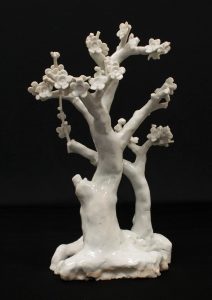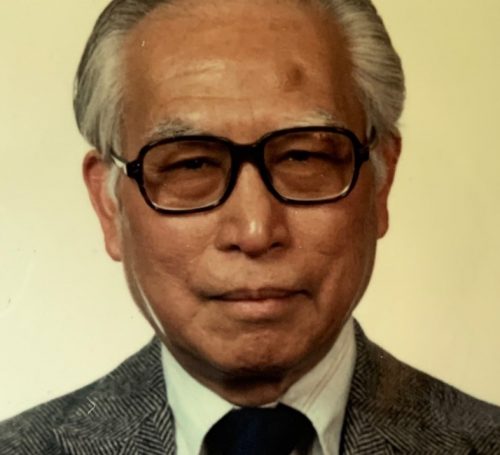Portrait of Dr. Wang Fang-yu in his later years
c. 1990s
MAY IS AAPI HERITAGE MONTH
AAPI Heritage Month recognizes the contributions of generations of people of Asian and Pacific Islander descent who have enriched America’s history and been instrumental to the country’s success. Wang Fang-yu, Professor Emeritus and Chair of the Department of Asian Studies at Seton Hall University serves as an exemplar of this spirit. Though he passed away almost 25 years ago, his efforts continue to support, promote and positively influence the study of Chinese language in the Asian Studies Program which, for over 50 years, has been recognized for its outstanding faculty and programs.[1] A pioneer in the teaching of the Mandarin language, he was part of a team which developed the first Chinese language teaching computer system. He also wrote several books and dictionaries on the Chinese language which are available to researchers through the Seton Hall’s Department of Archives and Special Collections.[2]
In addition to establishing new methods for teaching Mandarin, Wang Fang-yu founded and curated a large and distinguished collection of Asian art and artifacts while at Seton Hall University.[3] Along with Dr. Louis de Crenascol and Barbara (Kaufmann) Cate of the Art Department, Wang worked tirelessly to cultivate donations from some of the most distinguished private collections in the region. He was often competing with large institutions such as the Freer Gallery in Washington D.C, but he was persuasive, ultimately establishing a collection of hundreds of objects. The core of the collection consists of painted silk scrolls, ceramics and notable calligraphy pieces and it was the foundation of many exhibitions in the Art Center and other locations on campus prior to the building of the Walsh Gallery in 1994. The collection includes pieces from Korea, China, Japan, The Philippines and India, as well as other Asian and Pacific Island cultures.

An accomplished calligrapher in his own right, Wang’s art became the subject of exhibitions at the Walsh Gallery and numerous other venues including the Asian Society, The Newark Museum of Art, The Duke University Art Museum and E & J Frankel Gallery in New York, one of the oldest galleries in the country to specialize in Asian art.[4] Wang was also an avid collector of artist Bada Shanren, a 17th century Chinese calligrapher and poet. In the image above you can see Meghan Brady, Collections Assistant at the Walsh Gallery, inspecting and documenting “Landscape”, attributed to Chu Ta, a pseudonym used by the artist. A recent exhibition at Fu Quimeng Gallery in New York City featured the work of Bada Shanren in tandem with Wang Fang-yu’s art.[5] The exhibition also included a special section dedicated to Wang Fang-yu’s ground-breaking art authentication system which used computers and comparative analysis techniques borrowed from linguists. The show, “Authentic or Forgery: How does a Chinese Connoisseur Work?” described how Wang’s use of computers and algorithms was way ahead of the curve in establishing the authorship of artworks. Wang’s scholarship was further revealed in the display of his manuscripts, photographs and writings.[6]
In a recent interview at Fu Quimeng Gallery, Shao Fang described how his father’s methods of art connoisseurship were not universally accepted when they were first developed in the 1960s.[7] People were skeptical of computers and his use of lingual theories as applied to art. Before this time, authentication was the domain of art historians, curators and scholars whose judgments were contingent on visual observations and instincts based on extensive knowledge of a subject. Wang Fang-yu was deeply appreciative of Seton Hall University’s embrace of his (then) unorthodox methods, which are no longer far outside of mainstream scholarship.

Ch’ing Dynasty
Mid to late 18th century China
79.40.10
Wang Fang-yu Collection of Asian Art
Courtesy of the Walsh Gallery
Seton Hall University is celebrating AAPI Heritage Month with a series of events. Students can vote for their favorite Asian American and Pacific Islander owned business and be entered to win a prize. The University Libraries has created a virtual display of books to highlight the breadth, culture and creativity of AAPI books, both fiction and non-fiction. To find other ways to participate, view the May calendar of events at Seton Hall University.
The Walsh Gallery has a considerable collection of fine art, artifacts and archeological specimens for use by faculty, students and researchers. For access to this or other objects in our collections, contact us at 973-275-2033 or walshgallery@shu.edu to make a research appointment.
[1] https://www.shu.edu/languages-literatures-cultures/asian-studies-languages-literatures-cultures.cfm, accessed 5/10/2021.
[2] https://en.wikipedia.org/wiki/Fred_Fangyu_Wang, accessed 5/10/2021.
[3] Typescript of the “Inventory – Wang Fang-yu Collection of Asian Art” by Dr. Lee de Crenascol, 1976, Walsh Gallery, Seton Hall University, South Orange, NJ, USA.
[4] http://www.allthegalleries.com/dealers/e-j-frankel-2492.html, accessed 5/10/2021.
[5] https://fuqiumeng.com/en/category/artists/fangyu-wang/, accessed 5/10/2021.
[6] https://fuqiumeng.com/en/wangfangyuexhibition/, accessed 5/10/2021.
[7] Shao Fang, gallery talk and interview with Dr. Sarah Ponichtera, Jeanne Brasile and Meghan Brady at Fu Quimeng Gallery, New York, NY, 1/31/2021.
